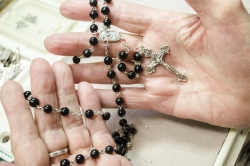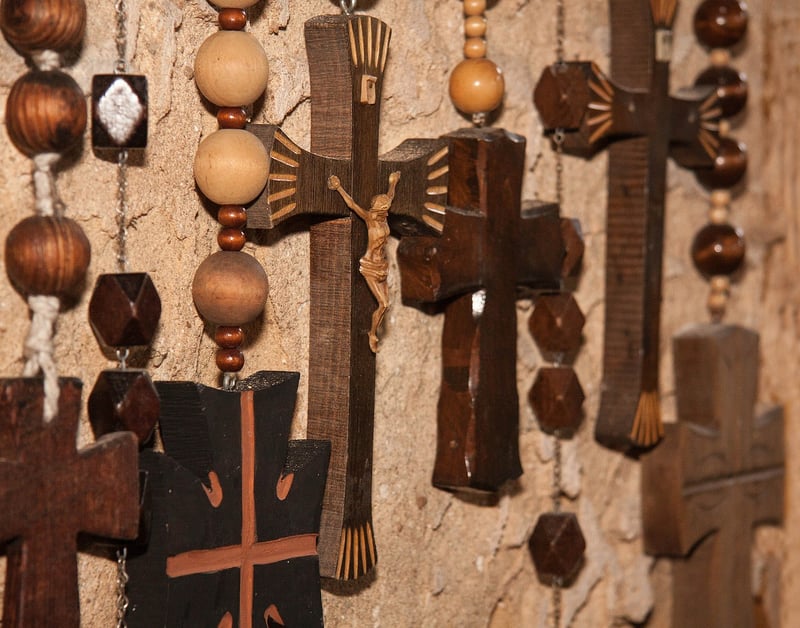 "We need to attach ourselves to the rosary like a rope that is held by the hand of Mary and then, we climb upwards, toward heaven!” Blessed James Alberione
"We need to attach ourselves to the rosary like a rope that is held by the hand of Mary and then, we climb upwards, toward heaven!” Blessed James Alberione
Brother John M. Samaha, of the Society of Mary, writes that the most likely pre-Christian ancestor of rosary beads originated in the ancient East. The English word bead derives from the Old English noun bede which means a prayer. The Desert Fathers of the third to fifth centuries used pebbles to keep track of the one-hundred-fifty psalms or to count the number of times they prayed the Jesus Prayer. The invention of the prayer rope is attributed to Saint Pachomius in the fourth century.
Following the Crusades, the Rosary found its way to the West, and the prayer form kept that name. “Rosary” comes from the Latin rosarium, which means a rose garden. Saint Dominic and his companions spread this devotion so that the Rosary became a popular method of prayer in the West during the Middle Ages.
For Christians, the rosary has always been “the Gospel strung on beads.” Blessed James Alberione wrote, “The rosary is a short theology if it is considered as a whole; it is a summary of the catechism… One could also call it the little theology of Jesus and of Mary. Together with the truths of the faith is interwoven the life of Jesus, the life of Mary.”
[Tweet "For Christians, the rosary has always been “the Gospel strung on beads".”]
The Dominican Rosary
Dominicans still follow the medieval custom of beginning the Rosary like the Little Office of the Blessed Virgin Mary: “God come to my assistance. Lord make haste to help me.” When I entered the convent this was the way we began the rosary. The Dominican Rosary prayed in a group is done in two choirs, as when praying the Divine Office.
The Franciscan Rosary
While the Dominicans are credited with the spread of the Rosary, Franciscans also have a deep devotion to the Blessed Mother. Francis “embraced the Mother of Jesus with an indescribable love, because she made the Lord of Majesty our brother.” The Franciscan rosary is called The Franciscan Crown. It has this name, according to legend, because the Blessed Mother asked an aspiring Franciscan friar to weave her a crown of prayers. The Franciscan Crown is a seven-decade rosary.
The Servite Rosary
Promoted by the Servite Fathers, the Servite Rosary is a Chaplet of the Seven Sorrows of Mary. consisting of seven sets of seven beads. While the Franciscan Crown is focused on the seven joys of Mary, the Servite chaplet is focused specifically on the seven sorrows. The word chaplet comes from the French word for Rosary. The term has become associated with specific prayers to Mary, Jesus, or the saints using fewer beads than a traditional Rosary and a different set of prayers.
The Queen of Apostles Rosary
My religious order, the Pauline Family, prays the Queen of Apostles Rosary. It is a Rosary that exemplifies the Marian Devotion of our founder Blessed James Alberione. “Mary is Queen of Apostles because she was chosen to be the Mother of Jesus Christ and to give Him to the world; she was made the Apostles’ Mother and our own by Our Savior on the cross; she was with the Apostles while awaiting the descent of the Holy Spirit, obtaining for them the abundance of supernatural graces they received on Pentecost.” The Queen of Apostles Rosary is a meditation on the first Joyful Mystery, the fifth Sorrowful Mystery, and the third, fourth, and fifth Glorious Mysteries.
The Rosary of St. John Paul II
Originally the selection of 150 prayers for the Rosary was determined by the number of the Psalms in the Psalter. St. John Paul added the Mysteries of Light to the traditional fifteen decades. “I believe that to bring out fully the Christological depth of the Rosary it would be suitable to make an addition to the traditional pattern which, while left to the freedom of individuals and communities, could broaden it to include the mysteries of Christ's public ministry between his Baptism and his Passion.”
Living the Mysteries with Mary
“Mary,” wrote Blessed Alberione, “lived out all these mysteries. She participated in the mysteries, and her prayerful reflection allowed her to draw out the vital meaning of the mysteries.” He invites us to “set devotion to Our Lady as a seal upon your whole life, that is, to live in such a way that she is always before you, presiding over your studies, your spiritual work, your apostolate: that she be always present in your entire life.”
What is your family Rosary tradition?
 Photo "Wall of Rosaries" by Stefan Schweihofer via
Pixabay (2014), CCO Public Domain
Photo "Wall of Rosaries" by Stefan Schweihofer via
Pixabay (2014), CCO Public Domain
Rosary Resouces:
- How to Pray the Rosary
Dominican Rosary
Franciscan Crown
Servite Rosary
Pauline Rosary Devotion Slideshare
John Paul II Apostolic Letter Rosarium Virginis Mariae
Father Peyton Website Dedicated to the Family Rosary
Rosary Miracle Prayer App
Copyright 2016 Sister Margaret Kerry, fsp
Sister Praying Rosary Photo copyright by Daughters of St. Paul, Used with Permission.
Wall of Rosaries Photo by Stefan Schweihofer (2014) via Pixabay, CC0 Public Domain.
About the Author

Sr. Margaret Kerry, fsp
A Daughter of St. Paul for 40 years Sr. Margaret continues to pursue new ways to proclaim the Gospel: sharing the Pauline Charism with the laity, writing books (St. Anthony of Padua: Fire & Light; Strength in Darkness: John of the Cross; Prayers for the New Evangelization), & through direct evangelization. She is available for workshops on the Vocation & Mission of the Laity, Media Literacy, and The New Evangelization. mkerry@paulinemedia.com


.png?width=1806&height=731&name=CatholicMom_hcfm_logo1_pos_871c_2728c%20(002).png)
Comments